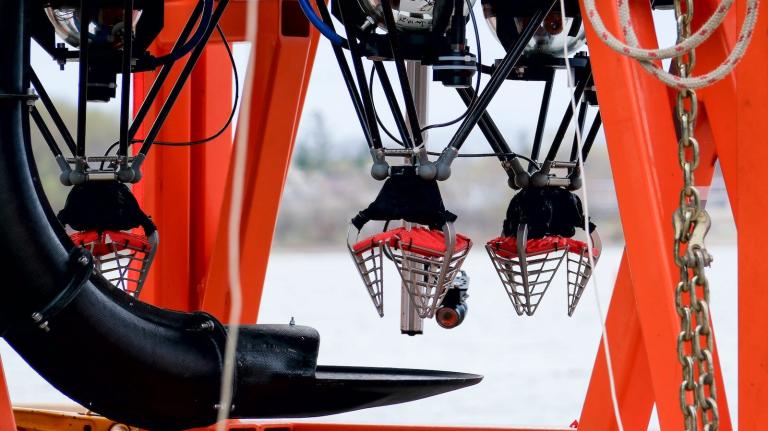The rest of the media is finally catching up to my post from last month.
That’s because Nature published the peer-reviewed paper that was first reported at the American Geophysical Union meeting and Nature‘s own blog (!), “Warming of the Antarctic ice-sheet surface since the 1957 International Geophysical Year” ($ub. req’d, abstract below).
Scientists know the Antarctic ice sheet is losing mass “100 years ahead of schedule.”
It is really only the warming of the West Antarctic Ice Sheet that you should worry about (at least for this century) because it’s going to disintegrate long before the East Antarctic Ice Sheet does — since WAIS appears to be melting from underneath (i.e. the water is warming, too), and since, as I wrote in the “high water” part of my book, the WAIS is inherently less stable:
Perhaps the most important, and worrisome, fact about the WAIS is that it is fundamentally far less stable than the Greenland ice sheet because most of it is grounded far below sea level. The WAIS rests on bedrock as deep as two kilometers underwater. One 2004 NASA-led study found that most of the glaciers they were studying “flow into floating ice shelves over bedrock up to hundreds of meters deeper than previous estimates, providing exit routes for ice from further inland if ice-sheet collapse is under way.” A 2002 study in Science examined the underwater grounding lines-the points where the ice starts floating. Using satellites, the researchers determined that “bottom melt rates experienced by large outlet glaciers near their grounding lines are far higher than generally assumed.” And that melt rate is positively correlated with ocean temperature.
The warmer it gets, the more unstable WAIS outlet glaciers will become. Since so much of the ice sheet is grounded underwater, rising sea levels may have the effect of lifting the sheets, allowing more-and increasingly warmer-water underneath it, leading to further bottom melting, more ice shelf disintegration, accelerated glacial flow, and further sea level rise, and so on and on, another vicious cycle. The combination of global warming and accelerating sea level rise from Greenland could be the trigger for catastrophic collapse in the WAIS (see, for instance, here).
You can read every thing a layman could possibly want to know about what the study does and doesn’t show at RealClimate here. Andy Revkin blogs on the NYT coverage of the study with expert commentary here.
It bears repeating that this was not the only research presented at the AGU meeting to find that warming extends beyond the Antarctic’s Peninsula region. David Bromwich of the Byrd Polar Research Centre at Ohio State also presented his new study, “Surface and Mid-tropospheric Climate Change in Antarctica,” which found:
It is found that the statistically significant Antarctic Peninsula near-surface warming on an annual basis has spread into West Antarctica reaching as far as east as the Pine Island Bay-Thwaites Glacier region.
The warming is most marked in recent years with 2007 being the warmest year in the 1960- 2007 interval … . The warming over West Antarctica is maximized in the spring (SON) and in that season statistically significant warming stretches across all of West Antarctica and into northern Victoria Land. Weak near- surface warming is found over East Antarctica and the continent as a whole on an annual basis although continental warming in the spring is statistically significant and driven largely by the strong and widespread changes in West Antarctica.
Here is the abstract of the new Nature study:
Assessments of Antarctic temperature change have emphasized the contrast between strong warming of the Antarctic Peninsula and slight cooling of the Antarctic continental interior in recent decades. This pattern of temperature change has been attributed to the increased strength of the circumpolar westerlies, largely in response to changes in stratospheric ozone. This picture, however, is substantially incomplete owing to the sparseness and short duration of the observations. Here we show that significant warming extends well beyond the Antarctic Peninsula to cover most of West Antarctica, an area of warming much larger than previously reported. West Antarctic warming exceeds 0.1 °C per decade over the past 50 years, and is strongest in winter and spring. Although this is partly offset by autumn cooling in East Antarctica, the continent-wide average near-surface temperature trend is positive. Simulations using a general circulation model reproduce the essential features of the spatial pattern and the long-term trend, and we suggest that neither can be attributed directly to increases in the strength of the westerlies. Instead, regional changes in atmospheric circulation and associated changes in sea surface temperature and sea ice are required to explain the enhanced warming in West Antarctica.
So notwithstanding the amateur meteorologist-deniers who sometimes comment on this blog and elsewhere about how cold it is outside right now, the whole damn planet is warming and melting — even in places that are much, much colder than anywhere in the continental United States.
This post was created for ClimateProgress.org, a project of the Center for American Progress Action Fund.



